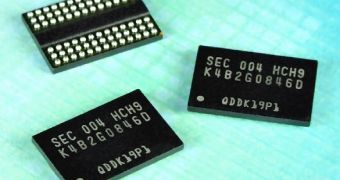It appears that, unlike the previous months, prices of DRAM chips didn't fall during the second half of February, although this may just be because of the fact that they have reached a level so low that their makers refuse to decrease them any further.
Some end-users may know that, over the past several months, prices of DRAM chips have been on a worrisomely fast decline.
Some may remember one of the main causes, that being how rapidly semiconductor companies advanced to better process technologies, causing oversupply.
In fact, they have come to be so cheap that high-capacity modules are affordable enough for some system builders to decide on doubling the base RAM capacity on their machines.
The downward trend was in effect until around early February, when it was noticed that chip makers were no longer willing to decrease their chips' ASPs (average selling prices) any further.
That said, a new Digitimes report reveals that, indeed, the prices of DRAM chips stayed flat during the second half of February.
Prices for 1 Gb and 2 Gb DDR3 chips were of US$0.88 and US$1.84, respectively, causing the prices of 2 GB and 4 GB DDR3 modules to stay level, at US$16.50 and US$32, respectively.
All in all, while the rest of a PC's hardware parts are priced more or less normally, RAM has become very cheap, for both desktops and laptops.
On that note, on February 24, spot prices for 1 Gb and 2 Gb DDR3 chips are set to have dropped about 1% to more or less US$1.09 and US$2.11, respectively.
Considering that CeBIT 2011, set to take place between March 1 and 5, should see the release of many new hardware and PC products, new sales opportunities for random access memory may or may not grow in number. Whether or not prices finally start to pick up remains to be seen.

 14 DAY TRIAL //
14 DAY TRIAL //